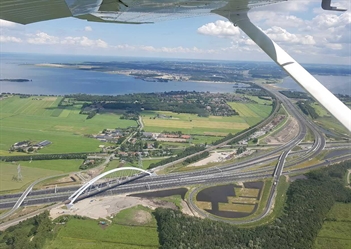Case study Getting a better picture of the road user
In order to limit disruption during the road works between Schiphol, Amsterdam and Almere (SAA) where possible, Rijkswaterstaat used the following various innovative measures. The deployment of Livecrowd is one example of this.
Livecrowd is a service that takes into account real-time information on road works and traffic disruption, and gives travellers personalised traffic advice via Facebook, Twitter and WhatsApp.
Livecrowd works via advertisements on social media. This is done using geofencing, where people who are in the vicinity of road works are 'targeted'. On the basis of their location, these people receive a message on their social media feed relating to the road works, and a link enabling them to use Livecrowd via existing social media platforms. So it is not necessary to install a separate app in order to use the service. Livecrowd can be used both ‘pre-trip’ and during the trip.
If you want to use Livecrowd as a traveller, you will first be asked whether or not you are the driver at that moment, in order to prevent use by someone who is currently driving. You can then choose whether you want to communicate via Facebook, Twitter or WhatsApp and you can ask your question.
In short: Livecrowd gives personal travel advice and answers questions during a weekend with disruptions. These are not automatically generated answers; the answers are provided by people at Livecrowd. This made it easy to adjust the answers during the weekend of disruptions, depending on the nature of the disruption that arose.
Background and aim
The aim of deploying Livecrowd during a weekend of disruptions is to reach a larger and different target group, in addition to the target groups already being reached through push messages, our own social media channels and other information facilities. Livecrowd is used as an additional measure, on top of other mobility-management measures.
Scope and effect
For SAA, Livecrowd was used for several weekends of disruptions. During the first weekend (10-12 March 2017), Livecrowd reached 141,635 unique devices. In addition, 775 messages were sent via WhatsApp in 227 chats, and 82 Twitter messages were sent.
In the second weekend, during which Livecrowd was deployed for 4 days, 112 Twitter messages were sent and 298 WhatsApp conversations took place. The Twitter conversations were seen by about 225,000 users in total. There was a clear growth in the reach between the first and second weekend.
The costs of deploying Livecrowd for a weekend of disruptions were around €15,000. It should be noted that this deployment was a pilot project that still included development costs.
Points for attention
- Make clear agreements in advance about when Livecrowd will be active, what the aim is, what questions are expected and what is needed.
- A condition for success is coordination with the 0800 (freephone) line, internal communications staff and the Rijkswaterstaat traffic managers.
- It is a great advantage if Livecrowd is physically on location with the traffic and communications managers during the weekend of disruptions. Short lines of communication work best.
- When deploying Livecrowd, the safety aspect of smartphone use in the car must be taken into account.
Can the measure be deployed more broadly?
Originally Livecrowd was a service that was deployed during events, but it is increasingly gaining its place in communications with road users during roadworks. Livecrowd is best used for a number of consecutive weekends of disruptions, because the start-up process takes a relatively long time.
While the deployment at SAA was also a pilot for Brandmkrs, the instrument is now being used at various locations in the Netherlands during roadworks, for instance on the Rhineland Route. It is now also possible to use the service for a longer period of time. In addition, Brandmkrs is increasingly making use of camera images and explanatory videos, which results in messages on Twitter and Facebook being better viewed.

